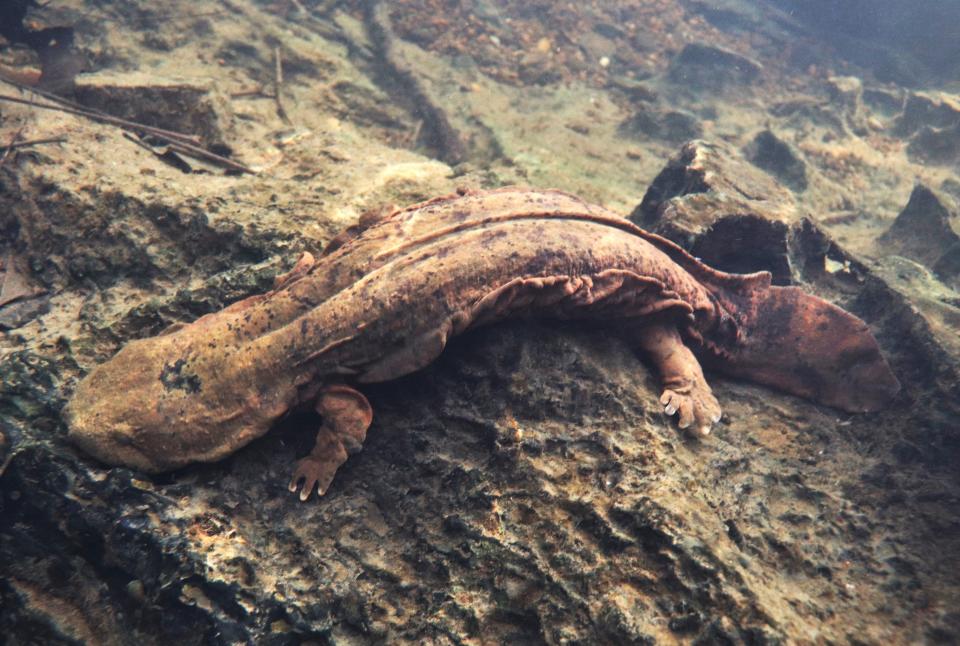Hellbenders are signs of healthy trout streams | ECOVIEWS
I recently heard Bill Hopkins, professor of fish and wildlife conservation at Virginia Tech University, give a talk about hellbenders, giant salamanders that can reach a length of more than 2 feet. They live in cold-water trout streams in several eastern states, historically ranging from southern New York, west into Missouri and Arkansas and south to northern Georgia and Alabama.
More: What is your favorite wildlife recipe? | ECOVIEWS
Sadly, hellbenders have disappeared from more than half of the streams where they once thrived, a cause for grave concern. Hopkins’ research demonstrates how these extraordinary salamanders serve as indicators of water quality, thus functioning as sentinels of the environmental health of a stream.
Two threats to hellbenders were already well known. If you go to a clear flowing stream where hellbenders abound, you are unlikely to see one, despite their large size. One reason is because hellbender hangouts are beneath large rocks in the streambed. Why would this be a problem? Because someone trying to find a hellbender for whatever reason rolls the rock. If a boulder sanctuary is dislodged, the animal’s home has been destroyed.

A second threat is an age-old problem faced by many wildlife species — gratuitous killing by some humans.
Certain offenders are anglers with the wrongheaded notion that the blame for their poor trout-catching day falls on hellbenders. But if hellbenders live in a stream, so can trout, which do not form part of the big salamander’s diet plan.
An enlightened angler in waders standing in a trout stream as clear as spring water is thrilled to see a hellbender. A benchmark species, they cannot survive in polluted waters.
After nearly a decade of conducting research by swimming around in ice-cold trout streams, Bill Hopkins identified a third threat to hellbenders that is insidious — a stream that's degraded because of environmental conditions upstream.
Hopkins' research focused on an unusual trait of hellbenders, one that sets them apart from most other animals — parental care provided exclusively by males. Male hellbenders prepare a nest under a big rock for one or more females to lay eggs. When the mothers leave, the dutiful father stays around, protecting the eggs and then the offspring from potential predators, including other hellbenders.
By comparing streams in which hellbenders have healthy populations with those where their numbers are declining, Hopkins’ painstaking research has revealed a potential source of the problem.
In streams where hellbenders are disappearing, he found that males are more likely to eat the eggs they are guarding. Eating its own offspring would appear to be maladaptive behavior for an animal. But under natural conditions, during lean years for food, many species display similar behavior.
However, such years would normally be infrequent and would be followed by years of plentiful resources when the population can recover. But if a stream is continually degraded, recovery cannot occur. No young salamanders are produced because fathers consume them for their own survival.
Eventually, the older adults die out. If hellbenders are declining or have disappeared from a stream, an upstream culprit may be the answer — forest or agricultural mismanagement. Pesticide runoff and siltation may need to be addressed.
Hellbenders are one of the largest, slimiest, meanest-looking, some say creepiest salamanders. An unkind observer might even describe them as grotesque. They have flat heads and bodies and four strong front toes for hanging on to rocks in fast-flowing mountain streams.
Because hellbenders never leave the water and breathe mostly through their skin, flabby folds on their sides provide greater exposure to oxygenated water. The presence of hellbenders in a stream means water quality is satisfactory.
By the usual standards of pulchritude, hellbenders would win no blue ribbons. But I find them appealing in a so-ugly-they're-cute sort of way.
Despite their physical beauty being off the charts in the wrong direction, hellbenders deserve our respect ecologically. They cannot persist in degraded waters. When they tell us the water quality of a mountain stream is unacceptable, we need to listen.

Whit Gibbons is professor of zoology and senior biologist at the University of Georgia’s Savannah River Ecology Laboratory. If you have an environmental question or comment, email ecoviews@gmail.com.
This article originally appeared on The Tuscaloosa News: Hellbenders are signs of healthy trout streams | ECOVIEWS

